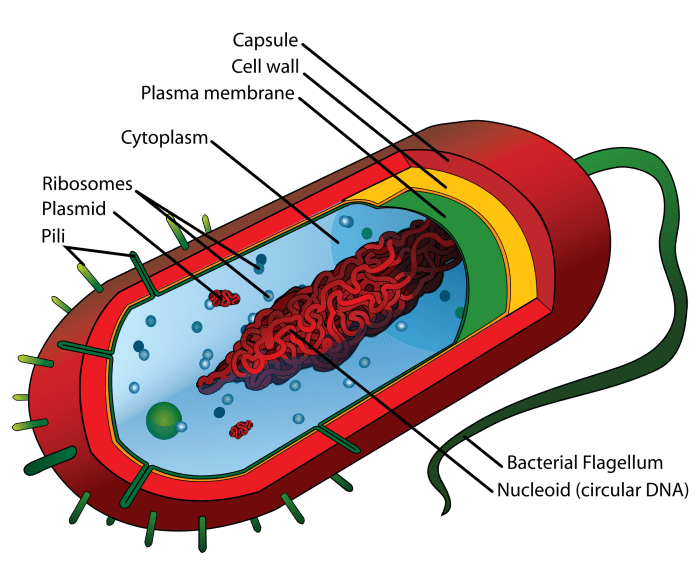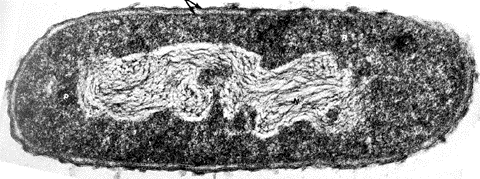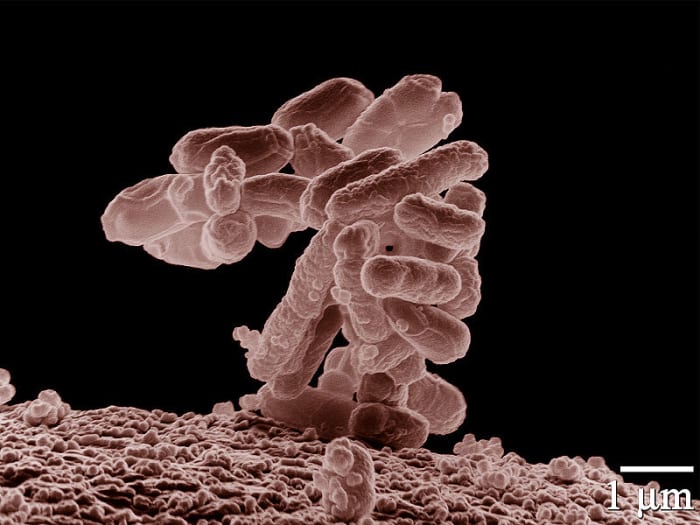What Structure Do A Prokaryotic Cell, A Plant Cell, And An Animal Cell Have In Common?

The gneralised structure of the Prokaryotes
Public Domain, via Wikimedia Commons
What Are Prokaryotes?
Prokaryotes are some of the oldest lifeforms on our planet. They have no nucleus and show huge variation. Many people know them better as 'bacteria' but, although all leaner are prokaryotes, non all prokaryotes are bacteria.
Eukaryotes have diversified into forms that have taken to the air, seas and earth; they take evolved into forms that tin can reform the World itself. However, they are still outnumbered, outcompeted and outdiversified by Prokaryotes. The prokaryotes incorporate the nigh successful division of life on our planet.
Quite different from the membrane-bound organelles of the Eukaryotes, the Prokaryotes are a stunning case of how there are many means to build a jail cell, many ways to survive, and many ways to thrive.
Prokaryote Cell Growth
Why are Bacteria so Successful?
Information technology is not the largest or the most intelligent of species, but those almost adjustable to change who will survive long term - just ask the dinosaurs. It is in this respect that prokaryotes excel.
Prokaryotes divide rapidly. The doubling fourth dimension beyond the grouping varies massively; some divide in a matter of minutes (E. coli - 20mins under optimum conditions; C. difficile - 7mins at optimum) others in a matter of hours (S. aureus - effectually an hour) and some double their number over days (T. pallidum - around 33hours). Fifty-fifty the longest of these doubling times is still hugely faster than the reproduction rates of eukaryotes.
Every bit natural choice works on the generational time calibration, the more generations that pass, the more 'fourth dimension' natural selection has to select for or confronting the dirt of evolution - the genes. As a batch of E. coli can double (with perfect weather condition) fourscore times in a 24 hour period, this provides huge opportunity for advantageous mutations to arise, be selected for, and spread throughout the population. This is, in essence, how antibody resistance develops.
This huge capacity for alter is the secret of prokaryote's success.
Construction of Prokaryotic Cells

Prokaryotic cells are much older than Eukaryotes. Prokaryotes lack whatsoever membrane-bound organelles; that means no nucleus, no mitochondria or chloroplasts. Prokaryotes oftentimes have a slimy capsule and flagella for movement.
Public Domain, via Wikimedia Commons
Cell Structure
| Construction | Prokaryotes | Eukaryotes |
|---|---|---|
| Nucleus | No | Yes |
| Mitochondria | No | Yep |
| Chloroplasts | No | Plants only |
| Ribosomes | Yes | Yes |
| Cytoplasm | Yep | Yes |
| Jail cell Membrane | Yes | Yep |
| Sheathing | Sometimes | No |
| Golgi Appliance | No | Yes |
| Endoplasmic Reticulum | No | Yep |
| Flagellum | Sometimes | Sometimes in animals |
| Cell Wall | Aye (not cellulose) | Plants and Fungi but |
Prokaryotic Cell Micrograph

A simulated colour micrograph of dividing Eastward. coli
Public Domain, via Wikimedia Commons
Cytoplasm
The cytoplasm plays, if possible, an even more than important role in prokaryotes than it does in eukaryotes. It is the site of all chemical reactions and processes that take identify in the prokaryotic cell.
Another departure from the eukaryotic cell is the presence of small, circular, extrachromosomal DNA known every bit plasmid. These replicate independently of the cell, and can exist passed on to other bacterial cells. This occurs in two ways. The first is obvious - when the bacterial cell divides via a process called binary fission - plasmids are often passed on to the girl cell because the cytoplasm is divided every bit between the cells.
The 2d method of transmission is through bacterial conjugation (bacterial sexual practice) where a modified pilus will exist used for transfer of genetic material between two bacterial cells. This can result in a single mutation spreading through an entire bacterial population. This is why information technology is then important to cease any course of antibiotics prescribed. A single surivor tin spread its advantageous genes to existing bacteria in your body, and any progeny of the cell will share its antibody resistance.
Plasmids tin encode genes for virulence, antibody resistance, heavy metal resistance. These have been hijacked by humanity for genetic engineering
Curlicue to Keep
Read More From Owlcation

The Deoxyribonucleic acid is in i long strand kept in a special expanse of the cytoplasm called the Nucleoid. It may await dark on a micrograph, but don't make the fault of calling information technology a Nucleus!
CC:Past:SA, Dr. Due south Berg, via PBWorks
Nucleoid
Prokaryotes are named for their lack of nucleus (pro= earlier; karyon=kernal or compartment). Instead, Prokaryotes have a single continuous strand of Dna. This DNA is found naked in the cytoplasm. The region of the cytoplasm where this DNA is found is called the 'Nucleoid'. Different eukaryotes, prokaryotes practise not accept several chromosomes...although one or two species practise have more than one nucleoid.
The Nucleoid is not the only region where genetic textile can be found, withal. Many bacteria has circular loops of DNA called 'plasmids' that can be found throughout the cytoplasm.
The Deoxyribonucleic acid is also organised differently in Prokaryotes and Eukaryotes.
Eukaryotes wrap their Deoxyribonucleic acid carefully around proteins called 'histones'. Think of how cotton wool is wrapped around its spindle. These are laid on top of each other in rows to requite the advent of 'beads on a string'. This helps condense the enormous length of Dna into something pocket-size enough to fit into a cell!
Prokaryotes do not parcel their DNA in this mode. Instead, prokaryotic DNA twists and twines effectually itself. Imagine twisting a couple of bracelets around one another.
Ribosomes
Any difference between Eukaryotic and Prokaryotic cells has been exploited in the ongoing war with pathogenic bacteria, and the ribosomes are no exception. At its most simple, the ribosomes of bacteria are smaller, made of unlike subunits than those of eukaryotic cells. As such, antibiotics tin be designed to target prokaryotic ribosomes whilst leaving the eukaryotic cells (due east.g. our cells or the cells of animals) unharmed. With no operation ribosomes, the cell cannot complete protein synthesis. Why is this important? Proteins (commonly enzymes) are involved in virtually all cellular functions; if proteins cannot be synthesised, the cell cannot survive.
Unlike in eukaryotic cells, ribosomes in prokaryotes are never found spring to other organelles

Low-temperature electron micrograph of a cluster of E. coli bacteria, magnified 10,000 times
Public Domain, via Wikimedia Commons
The Prokaryotic Envelope
At that place are many mutual structures inside a prokaryotic cell, only information technology is the exterior where we can run across most of the differences. Each prokaryote is surrounded past an envelope. The structure of this varies between prokaryotes, and serves as a key identifier for many prokaryotic prison cell types.
The cell envelope is made upward of:
- A Cell Wall (made of peptidoglycan)
- Flagella and Pili
- A sheathing (sometimes)
Prokaryotes

Coloured Electron Micrograph of Pseudomonas fluorescens. The sheathing provides protection for the cell and is seen in orange. Flagella are also seen (whiplike strands)
Photo Researchers
Capsule
The capsule is a protective layer possessed by some Bacteria that enhances their pathogenicity. This surface layer is made upward of long strings of polysaccharides (long chains of sugar). Depending on how well this layer is stuck to the membrane it is chosen either a capsule or, if not well adhered, a slime layer. This layer enhances pathogenicity by acting as an invisibility cloak - information technology hides the cell surface antigens that white blood cells recognise.
So important is this capsule to the virulence of certain leaner, that those strands without a capsule do not cause affliction - they are avirulent. Examples of such leaner are E. coli and S. pneumoniae

Bacterial cell walls are categorised co-ordinate to whether they take up Gram Stain. Therefore they are named Gram positive and Gram Negative
CEHS, SIU
Prokaryotic Cell Wall
The Prokaryotic Cell Wall is fabricated of a substance called peptidoglycan - a carbohydrate-protein molecule. The precise brand up of this varies hugely from species to species, and forms the ground of prokaryotic species identification.
This organelle provides structural support, protection from phagocytosis and dessication and comes in 2 categories: Gram Positive and Gram Negative.
Gram Positive cells retain the royal gram stain considering their cell wall structure is thick and circuitous enough to trap the stain. Gram Negative cells lose this stain because the wall if much more sparse. A diagramatic representation of each blazon of jail cell wall is given opposite.
Flagellum Types
Pili

Bacterial Conjugation. Here we can run into a plasmid beingness transferred along this hair to some other cell. This is how antibiotic resistance tin exist passed on to other pathogens
Science Photo Library
Flagella and Pili
All living things react to their surroundings, and bacteria are no different. Many bacteria use flagella to move the cell towards or away from stimuli such as low-cal, food or poisons (such as antibiotics). These motors are marvels of evolution - far more efficient than anything humanity has created. Contrary to common belief, these structures tin can be found all over the surface of a bacterium, not just at the end.
The video looks at some of the different organisations of flagella (audio quality is slightly fuzzy).
Pili are smaller, hairlike projections that sprout over the surface of nearly bacteria. These often act as anchors, securing the bacterium to a rock, intestinal tract, tooth or peel. Without such structures, the jail cell loses virulence (its' ability to infect) as information technology cannot hold on to the host structures.
Pili can also be used to transfer DNA between different prokaryotes of the same species. This 'bacterial sexual activity' is known as conjugation, and allows for more genetic variation to develop.
How Minor are Prokaryotes?

Prokaryotes are smaller than animal and plant cells, but much larger than viruses.
CC:BY:SA, Guillaume Paumier, via Wikimedia Commons
How do Antibiotics piece of work?
Different cancer therapy, the treatment of pathogens is usually well targetted. Antibiotics attack proteins or structures (such as the sheathing or pili) that have no eukaryotic analogue. Due to this, the antibiotic can impale prokaryotes whilst leaving the eukaryotic cells of the animal or homo intact.
There are several classes of antibiotics, classified co-ordinate to how they work:
- Cephalosporins: first discovered in 1948 - they prevent proper production of a bacterial jail cell wall.
- Penicillins: the first class of antibiotic discovered in 1896 then rediscovered by Flemming in 1928. Florey and Chain isolated the active ingredient from the penicillium mould in the 1940s. Prevent proper production of bacterial cell walls
- Tetracyclins: interfere with bacterial ribosomes, preventing protein synthesis. Due to more pronounced side-effects, this is not frequently used with common bacterial infections. Discovered in the 1940s
- Macrolides: some other protein synthesis inhibitor. Erythromycin, the kickoff of its class, was discovered in the 1950s
- Glycopeptides: forestall polymerisation of the cell wall
- Quinolones: interefere with important enzymes involved with Dna replication in prokaryotes. Due to this they accept very few side-effects
- Aminoglycosides: Streptomycin, which was also developed in the 1940s, was the first to be discovered in this course. They demark to the smaller bacterial ribosome subunit, thus preventing protein synthesis. These do not work well against anaerobic leaner.
Video Review of Prokaryotic Cells
© 2011 Rhys Baker
Jaden on Nov 25, 2019:
lots of data.
Science bot on Oct 10, 2019:
error error cocky devastation in ten,nine,8,vii,half-dozen,5,4,iii,2,one *explosion* x-10
bye on May 15, 2019:
does not assist i am non going to use this web cite ag
Rhys Baker (author) from Peterborough, UK on Dec 11, 2013:
Non weird-prudent. They are, subsequently all, the dominant life course on our planet!
Thank you for stopping past and welcoming me back. Hopefully you will check this out again when it is finished? You will be able to test your cognition in the mighty bacteria quiz :)
Deya Writes on December 10, 2013:
Is it weird to say I beloved leaner? Peradventure a petty, simply now that I become to do enquiry on them I find them even more fascinating trivial things
Source: https://owlcation.com/stem/What-Are-Cells-Made-Of-Prokaryotic-Cell-Structure-Part-3-of-3
Posted by: callenderrobef1979.blogspot.com

0 Response to "What Structure Do A Prokaryotic Cell, A Plant Cell, And An Animal Cell Have In Common?"
Post a Comment